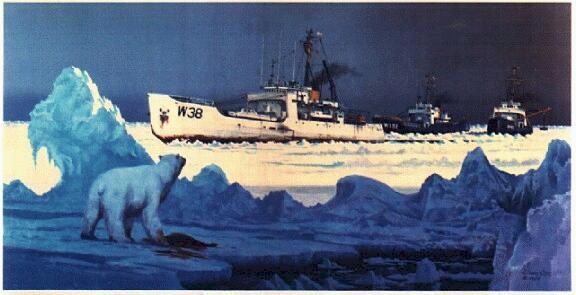

Click here to see the video of the historic Northwest Passage Voyage
Passage in the Ice
United States Coast Guard cutters Storis, Spar, and
Bramble were bucking the broad swell' of the North Pacific this week, on their
way to the Arctic and to the high adventure, their commanders hoped, of sailing
across the roof of the continent to New York City. Their mis-sion: To find an
escape route for radar-line supply ships which might become trapped in the
Arctic by ice or war.
Stations of the Distant Early Warning (DEW) radar line in the Arctic are
supplied by sea. Ice could prevent ships from returning to the Pacific and in
time of war enemy planes and submarines might make Bering Strait too dangerous
to use. Hence the search for a way out to the Atlantic.
The cutter cleared Seattle, Wash., last week and set course for Nome, Alaska.
On leaving Nome the expedition has orders to sail up through Bering Strait and
then eastward along the north shore of Alaska into Canadian waters. Once into
the tortuous maze of islands, shoals, and ice floes which is the Western
Canadian Arctic, the three stubby little ships will steam through Amundsen
Gulf, then twist their way through a succession of semi charted passages with
historic sounding names-Dolphin and Union Strait, Coronation Gulf, Dease Strait,
Queen Maud Gulf, Simpson Strait, Rae Strait, James Ross Strait, Franklin Strait
and at last turn into the narrow natural canal called Bellot Strait.
This is the key point of the expedition I for it is through Bellot Strait
that the task force hopes to pioneer the big elusive escape route. If the Storis,
Spar and Bramble can find a deep-water channel there, they will steam up Prince
Regent Inlet to rendezvous with HMCS Labrador, Canadian Navy icebreaker, in
Lancaster Sound near Resolute. The icebreaker will accompany them out through
Baflln Bay and Davis Strait to the Atlantic, and the escape route will be open
for traffic. If all goes well, they should reach New York in September.
Expert: Pilot of the expedition is Squadron Leader Scott E. Alexander of the
Royal Canadian Air Force. Forty-four years old, a former Royal Canadian Mounted
Policeman, he is one of the RCAF's experts on the Arctic. He organ-ized and
headed the RCAF's famous Arctic survival school, and helped invent the
nylon-pile fabric which now substi-tutes for caribou skin in Arctic clothing and
which is. also used for synthetic fur coats. This will be the third summer that
Alexander has served as Arctic pilot for U.S. task forces. Last summer, when he
piloted the Storis with U.S. Navy vessels following in line astern, Storis�s
skipper chortled: "Look at us. The Coast Guard leads the Navy-and who leads
the Coast Guard? Why, a blankety -blank airman-and a Canadian at that."
This summer, the Canadian is doing it again.